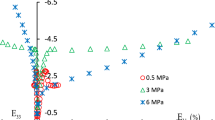Abstract
The stress and strain radial distributions within the minimum cross section of a tensile specimen undergoing necking, calculated with the Bridgman method, differ, in some cases substantially, from finite-element method (FEM) results. Analyses of the possible reasons for these differences show that an important role is played by the uniformity of the strain distribution assumed by Bridgman. In this study, three types of steels were subjected to tensile testing, and FEM analyses were performed to simulate the experimental trails. The comparison of the experimental and numerical results indicates the magnitude of the approximations intrinsic to the Bridgman method. Through further FEM analyses, it was possible to isolate, in qualitative terms, the influence of the Bridgman approximation from that of the void growth. This has been made by applying the Bridgman formulation to the proper FEM output data and comparing the resulting curves to the curves used as material input for the same analyses. Finally, it was found that, over a certain range of hardening materials, the correction of the true curve depends only on the necking strain, within the same error level given by the Bridgman method. This means that, once the corrective law common to many materials is found, then the correction procedure is substantially improved in terms of effort and time consumption, because it does not need the necking-curvature measurements required by the Bridgman method.
Similar content being viewed by others
References
P.W. Bridgman: Studies in Large Flow and Fracture, McGraw-Hill, New York, NY, 1956.
J.C. Earl and K.D. Brown: Eng. Fract. Mech., 1976, vol. 8, pp. 599–611.
M. Alves and N. Jones: J. Mech. Phys. Solids, 1999, vol. 47, pp. 643–67.
J.W. Hancock and D.K. Brown: J. Mech. Phys. Solids, 1983, vol. 31, pp. 1–24.
G. La Rosa, G. Mirone, and A. Risitano: Proc. XXVIII Italian Association for Stress Analysis Annual Congr., Vicenza, Sept. 1999, AIAS, Vicenza, Italy, 1999, pp. 371–80 (in Italian).
G. La Rosa, G. Mirone, and A. Risitano: Int. Conf. on Mechanics VI, WIT, Montreal, Canada, 2000, pp. 553–63.
A.C. Mackenzie, J.W. Hancock, and D.K. Brown: Eng. Fract. Mech., 1977, vol. 9, pp. 167–88.
G. Le Roy, J.D. Embury, G. Edwards, and M.F. Ashby: Acta Metall., 1981, vol. 29, pp. 1509–22.
A.L. Gurson: ASME Trans., J. Eng. Mater. Technol., 1977, vol. 99, pp. 2–15.
K. Santaoya: VTT Technical Research Centre of Finland Publication No. 312, Research Centre of Finland, Espoo, Finland, 1997.
R. Becker, A. Needleman, O. Richmond, and V. Tvergaard: J. Mech. Phys. Solids, 1988, vol. 36 (3), pp. 317–51.
A. Needleman and V. Tvergaard: J. Mech. Phys. Solids, 1984, vol. 32 (6), pp. 461–90.
V. Tvergaard and A. Needleman: Acta Metall., 1984, vol. 32 (1), pp. 157–69.
M. Geni and M. Kikuchi: Computational Mater. Sci., 1999, vol. 16, pp. 391–403.
R. Shiffmann, J. Heyer, W. Dahl, and W. Bleck: Int. Conf. on Damage and Fracture Mechanics VI, 2000, pp. 129–38.
A.R. Ragab and A.R.C. Saleh: Int. J. Plasticity, 1999, vol. 15, pp. 1041–65.
J.W. Hancock and A.C. Mackenzie: J. Mech. Phys. Solids, 1976, vol. 24, pp. 147–69.
G. La Rosa, G. Mirone, and A. Risitano: Proc. XIV Italian Group of Fracture Congr., Trento, May 1998, IGF, Trento, Italy, 1998, pp. 371–80 (in Italian).
G. La Rosa, G. Mirone, and A. Risitano: Proc. XV Italian National Congr. IGF, Bari, Italy, May 2000, AIAS, Bari, Italy, 2000, pp. 361–71.
J. Lemaitre: A Course on Damage Mechanics, Springer, New York, NY, 1996.
J. Lemaitre: J. Appl. Mech., 1988, vol. 55, pp. 59–72.
J. Lemaitre: Nucl. Eng. Design, 1984, vol. 80, pp. 233–45.
N. Bonora, P. Salvini, and F. Iacoviello: XXV AIAS National Meeting, Gallipoli, 1996, AIAS, Gallipoli (Lecce, Italy), 1996, pp. 345–55.
B. Marini, F. Mudry, and A. Pineau: Eng. Fract. Mech., 1985, vol. 22, pp. 375–86.
S. Argon, J. Im, and R. Safoglu: Metall. Trans. A, 1975, vol. 6A, pp. 825–37.
M. Saie, J. Pan, and A. Needleman: Int. J. Fracture, 1982, vol. 19, pp. 163–82.
G. La Rosa, G. Mirone, and A. Risitano: Eng. Fract. Mech., 2001, vol. 68 (4), pp. 417–34.
G. La Rosa, G. Mirone, and A. Risitano: Proc. XXX Italian Association for Stress Analysis Annual Congr., Sept. 2001, AIAS, Alghero (Sassari, Italy), pp. 649–55.
Author information
Authors and Affiliations
Rights and permissions
About this article
Cite this article
La Rosa, G., Risitano, A. & Mirone, G. Postnecking elastoplastic characterization: Degree of approximation in the bridgman method and properties of the flow-stress/true-stress ratio. Metall Mater Trans A 34, 615–624 (2003). https://doi.org/10.1007/s11661-003-0096-y
Received:
Issue Date:
DOI: https://doi.org/10.1007/s11661-003-0096-y




